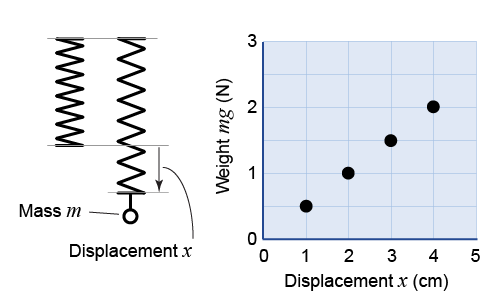|
When you stretch a spring, it pulls back on you; when you compress a spring, it pushes back. Moreover, the force exerted by the spring is generally proportional to the distance you push or pull it. This relationship is known as Hooke’s law. The strength of a spring is quantified by its spring constant k. A three-dimensional solid, such as a tabletop, sags under the weight of a load until a spring-like force opposes the weight. In general, the sag distance is proportional to the force applied by the load. Brittle objects crack or disintegrate after bending a very small amount, whereas elastic objects can be bent or stretched by large amounts without breaking. 
|
|
spring constant, spring, Hooke’s law, elasticity, brittle, material strength
|
|
|
|
Review problems and questions |
|
- Is the force F in Hooke’s law (F = −kx) the force applied to the spring by an outside agent, such as your hand?


|
No. Hooke’s law calculates the force applied by a spring onto the object or agent that is stretching or compressing the spring. 
|
- What is the physical significance of the negative (minus) sign in Hooke’s law?


|
The negative (minus) sign tells us that a stretched spring pulls back, whereas a compressed spring pushes back. In either case, the spring applies a force that “fights back,” as if the spring “wants” to return to its original size and shape. 
|
- Which of the following is a physically possible unit for the spring constant k? (More than one answer may be correct, and correct answers do not have to be in SI or metric units.)
- meters per second squared (m/s2)
- pounds per inch (lb/in)
- newtons per millimeter (N/mm)
- meters per newton (m/N)


|
Both b and c are physically meaningful units for the spring constant. Hooke’s law states that force equals the spring constant multiplied by the displacement of the spring (but in the opposite direction of the displacement). To cancel out the units of displacement and leave us with force, k must have units of force/distance. Pounds and newtons are both units of force, while inches and millimeters are both units of distance. Therefore choices b and c both have the correct dimensions for a force constant. (Choice a has units of acceleration, and choice d has units of distance/force—the reciprocal of what we need.) The SI unit for k is newton/meter (or N/m). 
|

- Chloe suspends a spring from a secure laboratory stand. Then, one by one, she attaches different metal objects to the spring. Each time, she measures and plots the metal object’s weight mg (in newtons) and the spring’s displacement x (in centimeters). She then plots her data as shown here. What is the spring constant k for her spring (in SI units)?


|
The spring constant is k = 50 N/m. The solution depends on several insights: - The object’s weight equals the magnitude (strength) of the force exerted by the spring. (This is because the object is in equilibrium, and so the net force upon it is zero.)
- The ordinate (y-axis) of the graph therefore shows the strength of the force F exerted by the spring.
- The spring indeed obeys Hooke’s law, because the graph shows a straight line. (This implies that the force will double if the displacement doubles, just as Hooke’s law predicts.)
- The slope of the graph has dimensions of force divided by distance. These are the dimensions of the spring constant, though not in pure SI units.
- The displacement units must be converted from centimeters to meters in order to state the spring constant in SI units.
Solution: Use the conversion The final result is therefore The spring constant k is 50 N/m in SI units. 
Take a Quiz | |

